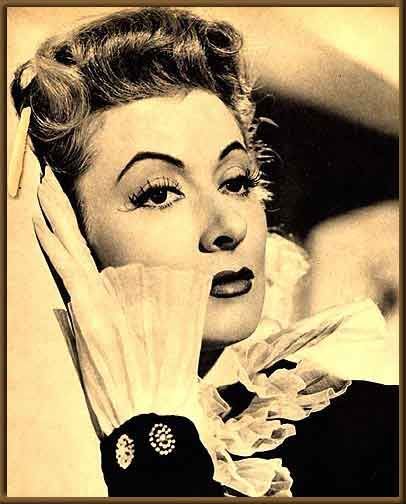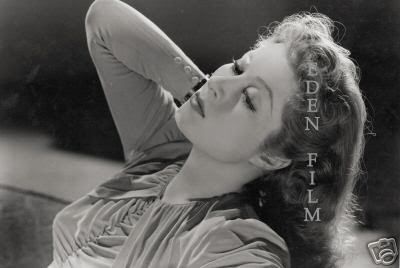Post by Miss Retro on Oct 4, 2007 12:47:52 GMT -5

From her arrival in Hollywood in 1939 until 1945, Greer Garson was one of the most famous women in the world. She received Academy Award nominations every year except for 1941 for a total of six. Thousands of fan letters flooded her mailbox each week. Her image could be found in magazines, coloring books, paper dolls, puzzles, and numerous novelty items. In December of 1944, she appeared on the cover of TIME magazine. But in 1946, a turn of events sent her star on a downward spiral. The war ended and the public's taste and the studio system in Hollywood began to change. Louis B. Mayer would leave MGM in a few years and Dore Schary would take his place. The elaborate expense once lavished on prestigious MGM films would be curtailed and more attention would be given to films dealing with realism and social issues. "Women's films", the type of movies that Greer Garson excelled in, would no longer be a top priority. Eventually, the arrival of television in the late 40's and early 50's would change the studio system forever.
In 1946, Greer was teamed with Clark Gable, who had just returned from the war, for Adventure. The catchy tag line proclaimed "Gable's back and Garson's got him!". The film did well at the box office, but it did not fare well with critics.
Also returning from the war was Greer's husband, Richard Ney. Ney returned to the studio but soon the combination of a highly famous actress struggling with bad luck at the studio and an aspiring actor trying to gain a foothold in his profession took a toll on their marriage. Ney did not deal well with Greer's success and furthermore, he did not enjoy sharing their home with the most important person in Greer's life, her mother. They separated and were divorced in September of 1946.
Greer's next film at MGM was a disaster. Desire Me was plagued by a bad script and tensions among the cast (director George Cukor and actor Robert Mitchum did not get along well). The escalating budget caused Cukor to be fired and the film was eventually directed by three other directors. In the end, no one wanted their name attached to it, and the film was released with no director credited!
Julia Misbehaves finally gave Greer the opportunity to appear in a comedy. playing a vaudeville actress mother who plays matchmaker to her daughter. The film was a hit and helped critics and fans forget about Desire Me.
During the filming of Julia Misbehaves, Greer was introduced to a man who would change her life forever. He was a Texas millionaire named Elijah "Buddy" Fogelson. Fogelson, who made his fortune in oil and cattle, owned a spectacular ranch in New Mexico called Forked Lightening Ranch and also maintained a residence in Dallas, Texas. Greer and Buddy became constant companions and soon fell in love. On July 15, 1949, following the completion of That Forsythe Woman, they were married in Santa Fe.
As Buddy Fogelson entered Greer's life, her priorities began to change and acting was not as important to her anymore except for projects that she really cared for. Her latest film, The Miniver Story, a remake of Mrs. Miniver, did poorly at the box office and reviews were bad. Greer turned her attention away from Hollywood as she soon fell in love with New Mexico. Surprisingly, ranch life suited her well, and she became interested in all aspects of cattle ranching and even bought her own steers and entered them into competitions.
She continued to work steadily in Hollywood throughout the 1950's, however, with the exception of Julius Caesar (1953), none of them were of the magnitude of her earlier films. She returned to the stage in late 1957 in the triumphant Auntie Mame and earned rave reviews.
Although Greer maintained her residence in Hollywood, her fondness for Santa Fe was strong. In late 1958, her beloved mother passed away. Nina Garson had been Greer's greatest ray of support throughout her life and career and she was always by her side. They always lived together and Greer even got Nina supporting roles in several of her films. Her death was a great loss to Greer.
Greer scored a great triumph in 1960 when she was offered the role of Eleanor Roosevelt in the film Sunrise at Campobello. The film, starring Ralph Bellamy as Franklin Roosevelt, dealt with his crisis with polio. Greer became a great friend to Eleanor Roosevelt and engrossed herself in researching her life. Her performance would earn her a seventh Academy Award nomination.
Greer would act in two more significant roles in the 1960's - The Singing Nun and The Happiest Millionaire. She also did lots of television work. The bulk of her time, however, would be spent in Santa Fe where she immersed herself in charity work. Buddy and Greer's generous contributions to the College of Santa Fe would be rewarded by the dedication of the Greer Garson Theatre in 1965, and later, the E.E. Fogelson Library. An honorary doctorate would also be bestowed to Greer, an award that she would cherish.
In 1975, Greer appeared at the Greer Garson Theatre in The Madwoman of Challiot. It would be her final stage performance. She continued to do television work, appearing in the tele-film Little Women and on the popular series The Love Boat.
Buddy Fogelson was diagnosed with Parkingson's disease in 1982 and his health steadily deteriorated throughout the 1980's. Greer declined all engagements to be by his side. He died on December 1, 1987 in Dallas, Texas, where they were now living. Greer's health was also quite delicate (she had suffered a minor stroke in 1980) and her doctor recommended that the altitude of Santa Fe would be bad for her heart.
Following Buddy's death, Greer continued to administer the Fogleson fortune to various charities in Texas and New Mexico, notably The College of Santa Fe and Buddy's alma mater, the Southern Methodist University in Dallas. A second Greer Garson Theatre was unveiled at SMU in 1992 but sadly, Greer was unable to attend the dedication ceremony due to her frail health.
In 1992, Greer moved into a suite at the Dallas Presbyterian Hospital where her health could be monitored continually. She continued to see friends and family but her heart was very fragile. She died on April 6, 1996.
[/center]In 1946, Greer was teamed with Clark Gable, who had just returned from the war, for Adventure. The catchy tag line proclaimed "Gable's back and Garson's got him!". The film did well at the box office, but it did not fare well with critics.
Also returning from the war was Greer's husband, Richard Ney. Ney returned to the studio but soon the combination of a highly famous actress struggling with bad luck at the studio and an aspiring actor trying to gain a foothold in his profession took a toll on their marriage. Ney did not deal well with Greer's success and furthermore, he did not enjoy sharing their home with the most important person in Greer's life, her mother. They separated and were divorced in September of 1946.
Greer's next film at MGM was a disaster. Desire Me was plagued by a bad script and tensions among the cast (director George Cukor and actor Robert Mitchum did not get along well). The escalating budget caused Cukor to be fired and the film was eventually directed by three other directors. In the end, no one wanted their name attached to it, and the film was released with no director credited!
Julia Misbehaves finally gave Greer the opportunity to appear in a comedy. playing a vaudeville actress mother who plays matchmaker to her daughter. The film was a hit and helped critics and fans forget about Desire Me.
During the filming of Julia Misbehaves, Greer was introduced to a man who would change her life forever. He was a Texas millionaire named Elijah "Buddy" Fogelson. Fogelson, who made his fortune in oil and cattle, owned a spectacular ranch in New Mexico called Forked Lightening Ranch and also maintained a residence in Dallas, Texas. Greer and Buddy became constant companions and soon fell in love. On July 15, 1949, following the completion of That Forsythe Woman, they were married in Santa Fe.
As Buddy Fogelson entered Greer's life, her priorities began to change and acting was not as important to her anymore except for projects that she really cared for. Her latest film, The Miniver Story, a remake of Mrs. Miniver, did poorly at the box office and reviews were bad. Greer turned her attention away from Hollywood as she soon fell in love with New Mexico. Surprisingly, ranch life suited her well, and she became interested in all aspects of cattle ranching and even bought her own steers and entered them into competitions.
She continued to work steadily in Hollywood throughout the 1950's, however, with the exception of Julius Caesar (1953), none of them were of the magnitude of her earlier films. She returned to the stage in late 1957 in the triumphant Auntie Mame and earned rave reviews.
Although Greer maintained her residence in Hollywood, her fondness for Santa Fe was strong. In late 1958, her beloved mother passed away. Nina Garson had been Greer's greatest ray of support throughout her life and career and she was always by her side. They always lived together and Greer even got Nina supporting roles in several of her films. Her death was a great loss to Greer.
Greer scored a great triumph in 1960 when she was offered the role of Eleanor Roosevelt in the film Sunrise at Campobello. The film, starring Ralph Bellamy as Franklin Roosevelt, dealt with his crisis with polio. Greer became a great friend to Eleanor Roosevelt and engrossed herself in researching her life. Her performance would earn her a seventh Academy Award nomination.
Greer would act in two more significant roles in the 1960's - The Singing Nun and The Happiest Millionaire. She also did lots of television work. The bulk of her time, however, would be spent in Santa Fe where she immersed herself in charity work. Buddy and Greer's generous contributions to the College of Santa Fe would be rewarded by the dedication of the Greer Garson Theatre in 1965, and later, the E.E. Fogelson Library. An honorary doctorate would also be bestowed to Greer, an award that she would cherish.
In 1975, Greer appeared at the Greer Garson Theatre in The Madwoman of Challiot. It would be her final stage performance. She continued to do television work, appearing in the tele-film Little Women and on the popular series The Love Boat.
Buddy Fogelson was diagnosed with Parkingson's disease in 1982 and his health steadily deteriorated throughout the 1980's. Greer declined all engagements to be by his side. He died on December 1, 1987 in Dallas, Texas, where they were now living. Greer's health was also quite delicate (she had suffered a minor stroke in 1980) and her doctor recommended that the altitude of Santa Fe would be bad for her heart.
Following Buddy's death, Greer continued to administer the Fogleson fortune to various charities in Texas and New Mexico, notably The College of Santa Fe and Buddy's alma mater, the Southern Methodist University in Dallas. A second Greer Garson Theatre was unveiled at SMU in 1992 but sadly, Greer was unable to attend the dedication ceremony due to her frail health.
In 1992, Greer moved into a suite at the Dallas Presbyterian Hospital where her health could be monitored continually. She continued to see friends and family but her heart was very fragile. She died on April 6, 1996.


